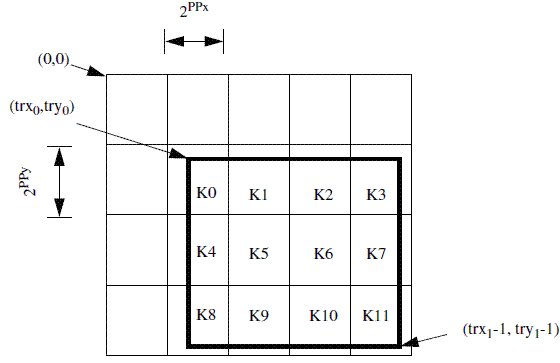JPEG2000标准中的Precinct(围地、子区)的定义和划分
JPEG2000标准对于图像区域的划分还是比较复杂的。对于一副彩色图像,JPEG2000把它按颜色空间划分为分量(component),按图像划分为切片(tile),在切片里面划分为分辨率(resolution)、子带(band)、区(precinct)。
切片、分辨率、子带还是比较好理解的,因为n级小波变换后就由n+1个分辨率,每个分辨率有3个子带(除去最低分辨率只有1个子带)。但区的划分和实现就有点麻烦了,官方文件ISO/ISE15444也没说清楚。经查阅有关资料和代码,原来如此。。。
在JPEG2000标准中,区的划分是对特定的切片、分量和分辨率进行的。比如说我们定义的区大小为(2PPx,2PPy),将分辨率r划分如图1所示,其中分辨率r的原点是(trx0,try0),右下角是(trx1-1,try1-1)。
图1
要注意到,虽然我们说得分辨率r划分为3个子带(最低分辨率为1个子带),但实际上我们的分辨率是一个矩形,对








 JPEG2000标准将图像按颜色空间划分为分量,切片和分辨率。在切片内,通过分辨率、子带和区进行划分。区的大小定义为(2PPx, 2PPy),并根据分辨率r的坐标(trx0, try0)至(trx1-1, try1-1)进行划分。在非最低分辨率下,每个区被划分为编码块,尺寸为2xcb'*2ycb',用于位平面、MQ编码等。区的划分有助于数据包化,减少传输错误影响,但可能增加系统开销并降低压缩效率。"
132177403,19625764,Matlab多子群改进海洋捕食者算法优化,"['算法', '开发语言', 'matlab', '优化']
JPEG2000标准将图像按颜色空间划分为分量,切片和分辨率。在切片内,通过分辨率、子带和区进行划分。区的大小定义为(2PPx, 2PPy),并根据分辨率r的坐标(trx0, try0)至(trx1-1, try1-1)进行划分。在非最低分辨率下,每个区被划分为编码块,尺寸为2xcb'*2ycb',用于位平面、MQ编码等。区的划分有助于数据包化,减少传输错误影响,但可能增加系统开销并降低压缩效率。"
132177403,19625764,Matlab多子群改进海洋捕食者算法优化,"['算法', '开发语言', 'matlab', '优化']

 最低0.47元/天 解锁文章
最低0.47元/天 解锁文章















 2150
2150

 被折叠的 条评论
为什么被折叠?
被折叠的 条评论
为什么被折叠?








